Despite my grumblings and self-recriminations, I am making some progress during these hot mid-summer days. An hour here and two hours there added up and I suddenly realized that I am, in fact, ready to attach the side boards—which will complete the hull and mark another important milestone.
First, however, I decided to circle the boat with my camera a take a few photos of the interior before it is hidden behind the side panels. I want to remember why the boat is taking so long to finish and I also decided, with some humility, that future Pocket Cruiser builders would like to see how I solved some of the boat’s small, but nettlesome design problems.
These close-ups aren’t especially inspiring, I admit, which is why most builders like to post artfully composed photos that emphasize the grace and beauty of their craft. I liked looking at these pretty pictures before I started my boat, but right now I am more interested in the blood and guts of boat building. Whenever I hit a snag, I find myself combing the Internet (usually without success) looking for close-ups that help me see how other people constructed their bilge board boxes, attached the transom to the keel, or secured their mastbox—among the dozen or more technical dilemmas that I have encountered over the past few months.
So for posterity and the edification of those who will build the next batch of Stevenen boats, here are a few images, enhanced with commentary and cautionary tales:
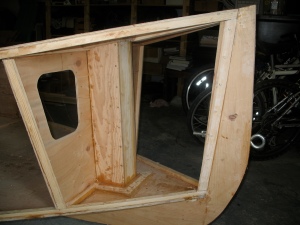
Figure 1

Figure 2
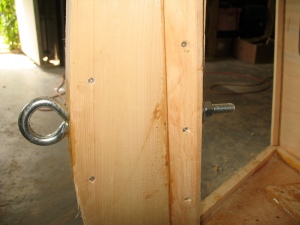
Figure 4
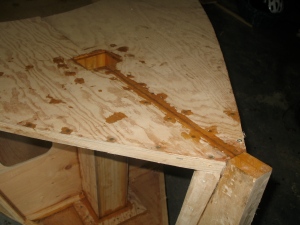
Figure 3

Figure 5
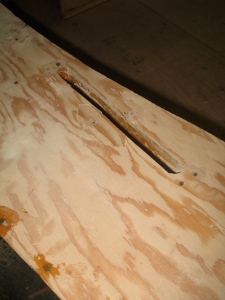
Figure 6

Figure 7
Let’s start at the bow of the boat. Figure 1 shows the front, from the forward bulkhead to the tip of the stem. Once the sides are attached, the many hours of interior work will be almost fully hidden, so before we seal the vault, so the speak, take note of the mastbox, which is attached to
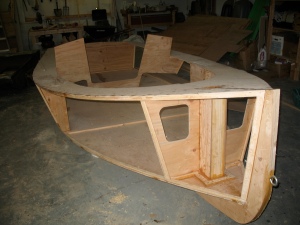
Figure 8
the inside edge of the bulkhead. Figure 2 shows how it is secured with plywood collars at both the top and the bottom. Stringers fill the remaining space.
The mastbox is sized to hold a 4 x 4 inch inch post (which is, of course, actually 3 ½ x 3 ½ inches). To assure an easy fit the box is about an 1/8 inch larger. To my inexperienced mind, this means that water will seep into the box, sit there and, since there is no draining mechanism, rot the wood. There is much discussion among Pocket Cruiser builders about this problem.
One faction advocates drilling small weep holes so that any accumulated water can drain away. Another group promotes encapsulating the inside of the box in epoxy. These are not mutually exclusive strategies, but for the moment, I followed the latter path and took the extra time needed to paint three coats of epoxy on all interior sides, including the boat bottom. For even more protection, I used epoxy when adhering the top and bottom collars. The rest of the boat will turn to oatmeal long before the mastbox will. Figure 3 shows the opening of the mastbox and the liberal use of epoxy.
Moving on to figure 4, please note the ten-inch eyebolt protruding through the stem. The bolt slides through a six-inch hole cut with an auger and secured on the inside of the hull. I fretted about drilling such a long hole, but old-fashioned augers allow for wonderfully precise drilling. The more serious concern was filling the hole after the eyebolt was inserted. I don’t like having a hole in the boat so close to the waterline and I spent a fair amount of time worrying that water would seep in, promote rot and make a puddle in the forward bulkhead. My simple solution was to line the inside of the hole with epoxy (using a small dowel to smear it around), then coat the bolt with as much thickened epoxy as it would hold and shove it in. Finally, I pushed in more thickened epoxy once the bolt was inserted and secured. I don’t know how well it will work, but it was the best I could do.
From here, let’s move toward the middle of the boat and pause at the bildge board boxes (figure 5). As I discussed in detail in an earlier post, I modified the size of the box slightly, making it both narrower and not quite a wide as the plans indicated. Also, I placed the box closer to the bottom edge of the boat. If I built and placed the box according to plans it would not fit underneath the deck. Pete Stevenson told me that I was the first to have this problem, but I suspect it’s more common than he knows. I know of at least two other builders who modified their boxes for one reason or another.
I made one other modification to the bilge board boxes: Based on the recommendation of builder Tom Christensen I angled the top of the box so that it would follow the upward curve of the bow. This allowed for a better fit and helped the deck maintain a graceful sweep from stem to stern.
The boxes were also encapsulated in epoxy and, as added precaution, secured to the boat bottom and deck with epoxy. Following the directions, I had little difficulty cutting out the slots in the top and bottom (see figure 6). Finally, I added two small partitions that attached to the sides of the boxes. They may or may not be necessary structurally, but they are part of the plans.
The tour is nearly complete, but I want to also show a close-up of the transom (figure 7), showing how the outside of the boat’s rear panel sits flush with the end of the keel and the keel’s capboard. The plans are bit vague on this point, but I looks like a flush surface is needed with attached the rudder mount later on, so it’s worth point out.
Finally, figure 8 offers the obligatory “pretty boat” view that shows how all the parts come together and remind me that I am making some progress after all.
I don’t pretend that I solved every problem or made the best decisions when I encountered a problem. But I am always grateful when other builders share their experiences and insights, even if I eventually blaze my own trail.



 Posted by Paul Boyer
Posted by Paul Boyer 